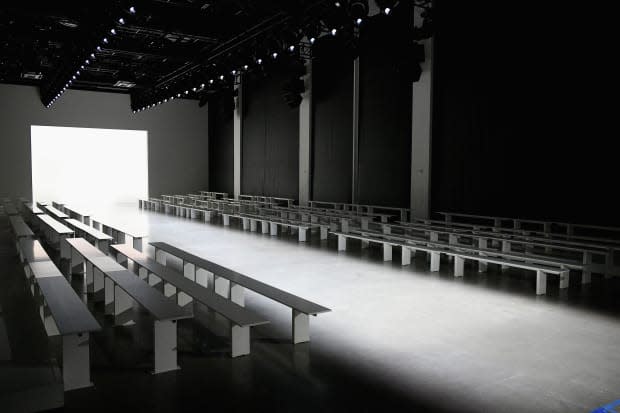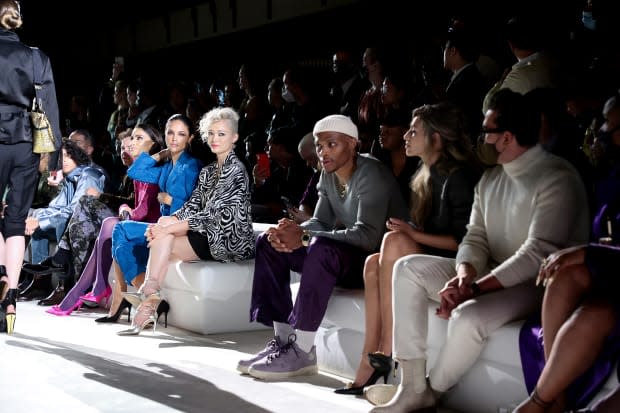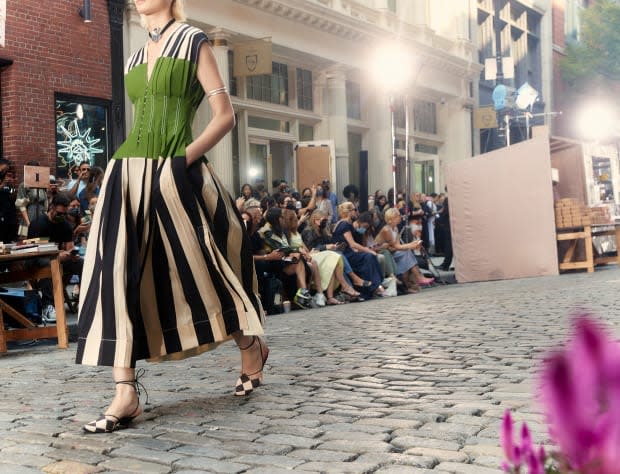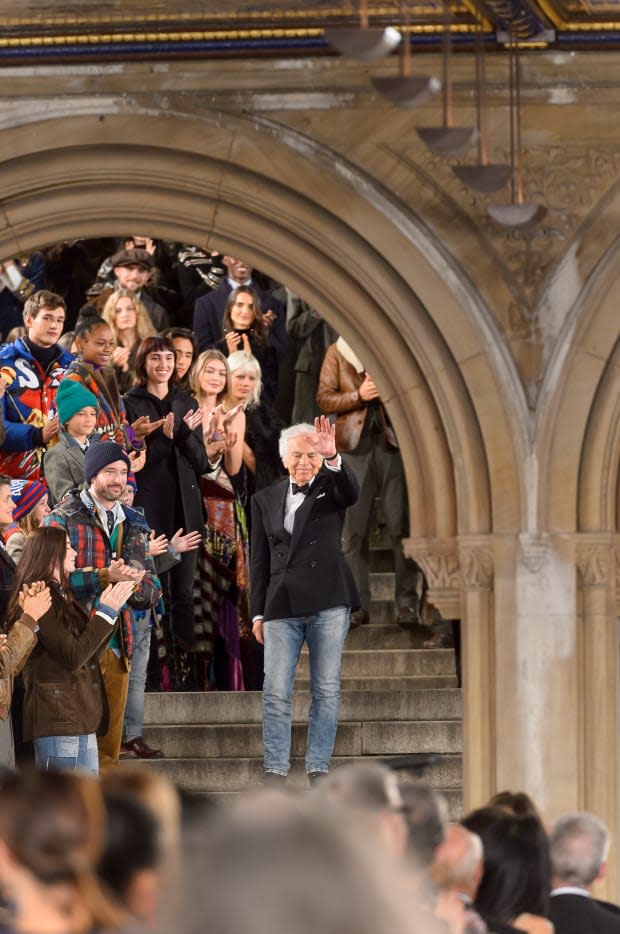The Making of a Fashion Show
Pulling together a memorable runway takes more than just putting incredible clothes on models. Lauren Paris of PR powerhouse KCD walks us through the planning process.
There's nothing quite like the experience of witnessing a truly great fashion show. Whether it's an outstanding new collection or a jaw-dropping set piece, you know it was good when you leave with exciting new ideas to think about.
What's not on your mind, if Lauren Paris has done her job right, are all those sticky moments that can make fashion week feel like a slog: an annoying seatmate, long wait times at the door, a view blocked by an influencer's assistant's cell phone. These are the sorts of details which fall under the "front of house" umbrella — that's PR speak for everything that guests interact with while the rest of the magic is happening backstage. Making it run smoothly is Paris' speciality as Vice President, PR Events and Department Manager at the powerhouse agency KCD.
"Running front of house, there's always new challenges, [and] I love a challenge; every event we do, it's different," she says. "I love seeing that come to life, but it does take a lot of planning."
For the shows in September, Paris and her team started planning all the way back in July. (As with many things in the fashion industry, it's necessary to leave August as a buffer when most of Europe goes on holiday.) The jumping-off point is always a timeline; once that's established, they can start working with the production and creative teams — who get cracking on shows even earlier — on establishing an outline of a seating chart or a capacity number. From there, those numbers get broken down even further to determine invites: Press, influencers and often VIPs are handled by KCD, while the clients' teams take control of the sales, personal friends and family lists.

Photo: Dia Dipasupil/Getty Images
As anyone who has worked in fashion over the last decade or so can tell you, guest lists look a bit different than they used to, and they're evolving at a faster rate than ever. In addition to all the usual players — key editors, important buyers, celebrity stylists — there's now the ever-changing influencer category. It started out with bloggers, then Instagrammers, then YouTubers and now, TikTokers; basically, if there's a content creator with an audience, they're finding their way onto invite lists.
"Especially with the parties, it's a whole new crowd," Paris says. "But it's fun, and it's exciting to develop new lists and meet new people and it's challenging. It's not just the same recipe every time."
Invites officially go out to that finalized list two to three weeks in advance. When RSVPs start rolling in — which begins almost right away — and the set design is locked down, the real work on the seating chart begins. Ideally, those are finalized with a few days to spare, but VIP sections are often subject to last minute shuffles, sometimes leading to day-of changes.
"I always think it's funny how much time we spend on a seating chart — I mean, we spend months, weeks, endless hours deciding who goes in each seat, when the guest is really in that seat for maybe 15 minutes," Paris says.

Photo: Dimitrios Kambouris/Getty Images
A good seating chart, according to Paris, is all about balance: Thought goes into sightlines, whether it's making sure an accessories editor is seated near an aisle so they can better spot the details or getting that influencer the best vantage point for capturing the big finale moment. The team also knows who needs a fast entrance or exit. (We've all spied a sunglasses-clad bob making a hasty retreat.) Then there's the matter of balancing personalities.
"The way that I like to seat shows is even if the person is in that seat for 15 minutes, you want them to have an enjoyable experience," Paris says. That may mean seating teams together, for those who roll deep, or trying to get friends seats next to one another; other times, it might mean mixing things up completely to shake people out of their comfort zones. Paris is happiest when those elements blend together perfectly.
"A good seating chart is [when] I feel like everyone has a good view or at least of the experience of it all; not everyone can see the model the first pass, but at least they can see the energy in the room," she says. "And that they're with people that make sense, whether they're in the same industry or they're friends, because you want people to be able to speak to someone that's next to them when they're waiting."
Of course, any show-goer's first interaction with a fashion show or party is the line to get in, which can be the trickiest flow to manage. Back when shows were held in a central location, like Bryant Park or Lincoln Center, there was a formula the KCD team could follow: seating layouts, front and back of house logistics, security and staffing more or less stayed the same from show to show. Now, with runways being held everywhere from abandoned subway stations to New York City streets, they have to flex their creative thinking muscles to keep the experience seamless for guests.
"We have to think about: How everyone's going to line up to check in? Where are we going to put the paparazzi and the street style photographers? How can we fast track the VIPs in? How can we get crashers out? That's a whole thing: Inevitably, there's obviously people that come that aren't on the list, and do we have a way to exit those people out?"

Photo: Imaxtree
Ah, yes, crashers — a fashion show staple since the beginning of time. With technology what it is today, it might be more difficult than ever to properly gatecrash an event. Every PR is armed with a "face book" that they've studied to recognize people they've invited, and digital invites often come with a photo attached, too. The KCD team recognizes the regular crashers ("I've seen them out in the real world, and I'm like, 'Oh my God, that's a crasher,'" Paris says, with a laugh), but it doesn't stop them from showing up — especially when they know their favorite celebrity is inside, or when there's a party at an iconic NYC venue.
"A party door is a whole different beast. That's fun. The night goes by quickly because people will say and do anything to get into these parties," Paris says. "It is hysterical, the things that I've seen, like the bribery or the insults. People come up with some interesting stories. And sometimes you feel bad! You're like, 'I wish I could just let them in — but, not gonna happen.'"
(Things that people have tried which won't work, just in case you were thinking of it: coming back a second time, claiming that it was your twin who tried to crash; filming the person working the door to intimidate them into letting you in.)
All of the best laid plans are nothing without staffers. This New York Fashion Week, KCD has more than 24 events happening over the course of seven days, which means Paris has to spend a lot of time sorting out the staffing puzzle. Days start hours before the first shows, which are often scheduled for 9 a.m., and can go into the wee hours of the morning — as late as 3 a.m., in the case of parties. Obviously, in an ideal world, you don't have a staff member bouncing from closing up a party to opening up a fashion show, but even in the best circumstances, sleep is in rare supply.
"We try to balance it. There's a lot of us, so we can be all hands on deck, for sure, so we can all catch up on sleep a little bit," Paris says. "But you have to [sacrifice] in order for it to go off without a hitch and run smoothly, and that's what we do. So that's okay — we can catch up on sleep in October."
A whole month of late nights and early mornings is the cost of doing business when you work for a firm that's in demand across all four major fashion cities. But for Paris, the hard work is worth it when everything comes together just right. Her standouts over her 14 year career include taking the Victoria's Secret Fashion Show worldwide, tackling a 50,000 person guest list for the opening of Hudson Yards (which involved working with traffic controllers — a first for her) and Ralph Lauren's 50th anniversary blowout in Central Park. "Those are the ones that are like, 'You are really a part of something special here,'" she says.

Photo: Imaxtree
Most recently, Paris and the KCD team pulled off the extravaganza that was Gucci's "Love Parade" show, a runway which took place smack in the middle of Hollywood Boulevard. Sure, the VIP list was packed and the people watching incredible, but for Paris, the best part was how seamless the experience was for attendees.
"I remember one of the guests came in, and he was like, 'Wow, it was so easy to get here. I'm assuming this was hard work for you guys, but that was really easy,'" she says. "That's exactly what you want the guests to say and think, because he has no idea how hard the planning and the process to get to that point was, so it was like, 'Oh my God, thank God that was easy for you.'"
Never miss the latest fashion industry news. Sign up for the Fashionista daily newsletter.
